By Crom: Arthurian Elements in the Conan Canon
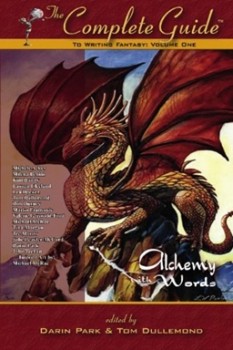 John Teehan, in The Complete Guide to Writing Fantasy: Volume One, challenges the reader to think of their favorite contemporary fantasy novels. And we’re talking Tolkien-onwards here, not just the past few years. Then he gives a list and says it would be difficult to think of a book that didn’t have any of the five themes on the list. He is making the point that the Arthurian legend, largely brought to popular culture by Thomas Malory, was an interweaving of those five themes. High fantasy epics like David Eddings’ Belgariad still follow this path.
John Teehan, in The Complete Guide to Writing Fantasy: Volume One, challenges the reader to think of their favorite contemporary fantasy novels. And we’re talking Tolkien-onwards here, not just the past few years. Then he gives a list and says it would be difficult to think of a book that didn’t have any of the five themes on the list. He is making the point that the Arthurian legend, largely brought to popular culture by Thomas Malory, was an interweaving of those five themes. High fantasy epics like David Eddings’ Belgariad still follow this path.
I immediately thought about Robert E. Howard’s Conan tales and how they didn’t really emulate this pattern. Or so it seemed to me. My friend Deuce Richardson immediately pointed out two stories that did significantly incorporate these elements. So, I decided to go back to the very beginning and take a good look at “The Phoenix on the Sword”: then, do a less detailed survey of the following stories.
So, here we go!
Characteristic One – Commoner who is Really a King
Well…we’re definitely 0 for 1 right out of the gate. I think of Shea Ohmsford, who is a descendant of Jerle Shannara (Terry Brook’s Sword of Shannara) or Belgarion in Eddings’ previously mentioned Belgariad). They have the lineage of kings (or great sorcerers) in their blood. And they rise up to perform great deeds or rule kingdoms.
Conan was born on a battlefield in the barbarian lands. He is a Cimmerian and presumably he was born there, though it’s possible it could have been during a raid into Vanaheim or Asgard: though I think that is highly unlikely. It’s generally accepted that his father was a blacksmith – though that’s an after-Howard addition. Regarding his right to rule, as Conan says in “The Scarlet Citadel:”
“You sit on satin and guzzle wine the people sweat for, and talk of divine rights and sovereignty – ha! I climbed out of the abyss of naked barbarism to the throne and in that climb I spilt my blood as freely as I spilt that of others. If either of us has the right to rule men, by Crom, it is I!”
That’s the definition of a self-made king right there.
Characteristic Two – Old Wizard Guides the Hero
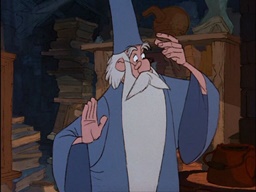 The old standby. Merlin, Gandalf, Allanon, Belgarath: the wise mentor with magical abilities is a standard archetype. Of course, sometimes, the wizard is the hero, such as Pug in Raymond Feist’s Riftwar Saga, Pug in Ursula K. LeGuin’s Earthsea Trilogy (of four books…) and Terry Pratchett’s Rincewind (I use the terms ‘hero’ and ‘wizzurd’ loosely in this instance). But this is step four of Joseph Campbell’s famous hero cycle: Supernatural Aid. In the Arthurian case, it’s in the form of a white-bearded, elderly wizard. You can see where Tolkien got the image from. With Saruman, he even did it twice!
The old standby. Merlin, Gandalf, Allanon, Belgarath: the wise mentor with magical abilities is a standard archetype. Of course, sometimes, the wizard is the hero, such as Pug in Raymond Feist’s Riftwar Saga, Pug in Ursula K. LeGuin’s Earthsea Trilogy (of four books…) and Terry Pratchett’s Rincewind (I use the terms ‘hero’ and ‘wizzurd’ loosely in this instance). But this is step four of Joseph Campbell’s famous hero cycle: Supernatural Aid. In the Arthurian case, it’s in the form of a white-bearded, elderly wizard. You can see where Tolkien got the image from. With Saruman, he even did it twice!
Regarding the mighty-thewed barbarian, now we see something. Conan distrusts and dislikes wizardry (usually referred to as sorcery in the Conan Canon) and his general approach to it is to apply cold steel (in the form of a sword) and repeat. But he does receive assistance from a couple of wizards across the twenty-one stories Howard wrote. And right out of the gate, we have one such instance. Conan is slumbering in his chambers; unaware foul treachery is creeping through his corridors. In his dream, he travels to a ‘black stone corridor in the black heart of Mount Golamira’ to the “phoenix-guarded tomb where Epimetrius was laid to rest fifteen hundred years ago.”
Epimetrius is a sage from ages past who battled Set in the service of his god, Ibis. He is apparently slumbering, not really dead. Set’s acolyte, who we know from the story is the Stygian wizard, Thoth-Amon, is stirring up trouble. Epimetrius has summoned Conan to ensorcel Conan’s sword, drawing the image of a phoenix on the blade with his finger. Suddenly, the dream ends and Conan springs awake in his room.
That magic blade is a key item in the final confrontation. In this story, we see the ‘Guiding Wizard’ archetype quite clearly.
Characteristic Three – Enchanted Sword or other Artefact of Great Magic
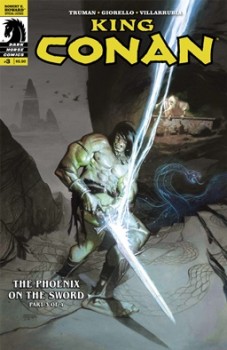 Of course, the Arthurian legends include Excalibur, the famed ‘Sword in the stone.’ In other versions, it is actually given to Arthur by the Lady of the Lake. Arthur returns Excalibur to the Lady in some, though not all, versions. It’s certainly the best-known ending.
Of course, the Arthurian legends include Excalibur, the famed ‘Sword in the stone.’ In other versions, it is actually given to Arthur by the Lady of the Lake. Arthur returns Excalibur to the Lady in some, though not all, versions. It’s certainly the best-known ending.
Michael Moorcock’s Elric wields Stormbringer. The soul-stealing sword is likely the most famous blade in sword and sorcery fiction. Corum, another aspect of the Eternal Champion, bore The Sword of the Dawn.
Fritz Lieber’s brawny barbarian, Fafhrd, had a magic sword named Graywand. Though he lost it more than once and it was replaced with another sword that became Graywand. It seemed more like a generic name that was applied to his current weapon.
Thor, most famous as a Marvel comic book and movie character, is one of the primary gods in Norse mythology. He wields Mjolnir, the powerful hammer that smites enemies and then returns when thrown.
Durendal was Roland’s sword in the stories of Charlemagne. That saga, known as The Matter of France, is an epic in the tradition of the Arthurian legends.
Of course, there are magic weapons spread throughout J.R.R. Tolkien’s tales of Middle Earth: Glamdring, Orcrist, Sting, Anglachel, Narsil. And the elven lord Gil-Galad had a mighty spear, Aiglos.
But magic weapons are almost non-existent in the Hyborian Age. It’s nothing like a Dungeons and Dragons adventure. As it happens, Howard chose to give Conan a magic sword in the very first story. Epimetrius enchanted the king’s great sword during the dream visit. When Conan faces a summoned demon in his chambers, it is impervious to ordinary weapons. The sword with the phoenix etched on it had broken earlier in the battle. But in desperation, Conan thrusts its shard into the demon, slaying it.
The magic blade saved the day. In fact, without it, there’s only one Conan story, as he would have been killed by the demon. So, that characteristic is very much present in the first tale.
Characteristic Four – A Quest for a Relic, Sometimes a Vessel, With Powers on a God-Like Scale
Starting with Arthur, it’s all about the Holy Grail; the cup of Christ.
Moorcock’s Eternal Champion, Dorian Hawkmoon, seeks the Runestaff.
Tolkien’s hobbits actually begin with The One Ring in their possession and the quest is to destroy it.
This motif is noticeably absent in the Conan Canon, with the notable exception of the lone novel, The Hour of the Dragon. It does appear in some of the pastiches written by other authors, but Howard himself did not build his stories around the object quest.
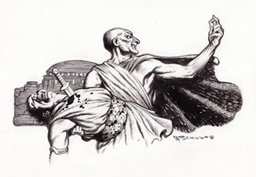 In “The Phoenix on the Sword,” there is a powerful item being sought for, but it’s not Conan doing the searching. Thoth Amon was a Stygian sorcerer who had lost his artifact, The Ring of Set and he is reduced to slave status because of this. He yearns to find the ring and resume his lofty status.
In “The Phoenix on the Sword,” there is a powerful item being sought for, but it’s not Conan doing the searching. Thoth Amon was a Stygian sorcerer who had lost his artifact, The Ring of Set and he is reduced to slave status because of this. He yearns to find the ring and resume his lofty status.
Thoth Amon appears in the first Conan story and is mentioned prominently in the third, indicating he might have been intended to be a major foe. But “The God in the Bowl” was never published during Howard’s lifetime and Thoth Amon is only named one more time, in The Hour of the Dragon. The sorcerer became a major character in L. Sprague de Camp’s pastiches and in graphic novels.
Characteristic Five – Diverse companions
I’m not quite sure what to make of this one. I think it primarily refers to the idea of a party of adventurers travelling together. The fellowship of the Ring is certainly what most comes to mind. The Knights of the Round Table were Arthur’s posse and went in search of the Grail.
There are a lot of characters in Conan’s adventures, but not the typical ‘party.’ He leads military and mercenary units and has commanders below him. There’s almost always a beautiful female of some type, whether co-adventurer or damsel in distress. And it’s not uncommon for him to have another fighter-type comrade (sometimes compelled by circumstances), whether in “Beyond the Black River” or “The Halls of the Dead.”
But he’s totally solo in “Phoenix.” All of the Cimmerian’s action takes place in a dream and then in his room after he wakes up. He fights off a plethora of invaders by himself, receiving unexpected aid from a demon at the very end. Then he’s on his own against the demon. So, a quick scorecard for the first story:
2/5 – “Phoenix on the Sword”
No – Commoner Who is Really a King
Yes – Old Wizard Guides the Hero
Yes – Enchanted Sword or other Artefact of Great Magic
No – A Quest for a Relic, Sometimes a Vessel, With Powers on a God-Like Scale
No – Diverse companions
2 out of 5 is probably an average score, maybe a little high, compared to the rest of the Conan Canon. Interestingly, “Phoenix” is a rewrite of an unsold Kull story, “By This Axe I Rule.” Howard added the wizard and the magic sword to the story when he reworked it for Conan. So, the original, unpublished story, scores a zero.
Let’s take a look at the next couple of stories, in the order written, and see how they fare:
0/5 – “The Frost Giant’s Daughter”
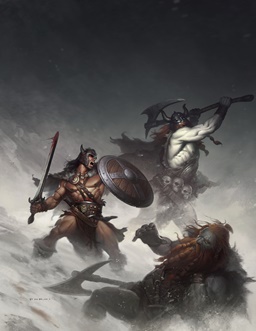 No – Commoner Who is Really a King
No – Commoner Who is Really a King
No– Old Wizard Guides the Hero
No – Enchanted Sword or other Artefact of Great Magic
No – A Quest for a Relic, Sometimes a Vessel, With Powers on a God-Like Scale
No – Diverse companions
Conan, the last survivor of a battle in the snowy north, chases a daughter of Ymir, slaying a pair of Frost Giants along the way. None of the characteristics at all. It’s actually a suitable hardboiled plot, with a femme fatale playing the badger game on Conan. She lures him to her cohorts, where they are going to ‘roll him’ (albeit for his heart, rather than his wallet). It’s hardboiled Nordic!
Of course, Conan’s actions as he grabs hold of Atali has generated a lot of commentary. I recently read a rather positive view of events in a well-respected Howard biography. I have a much darker take on Conan in this one.
0/5 – “The God in the Bowl”
No – Commoner Who is Really a King
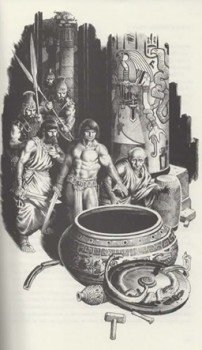 No– Old Wizard Guides the Hero
No– Old Wizard Guides the Hero
No – Enchanted Sword or other Artefact of Great Magic
No – A Quest for a Relic, Sometimes a Vessel, With Powers on a God-Like Scale
No – Diverse companions
Conan is robbing a museum when the proprietor is found dead. A relic from pre-Stygia is at the heart of matters. But there’s no quest for this coffin. It’s being sent to Kalanthes, a priest of Ibis.
And, because what good is it to write your own posts if you can’t engage in some shameless self-promotion, last year I wrote an essay positing that with “The God in the Bowl” Robert E. Howard was actually writing a police procedural before the term was even in use. That essay made the Preliminary List for the 2018 Robert E. Howard Foundation Awards. You can read it here.
4/5 – “The Tower of the Elephant”
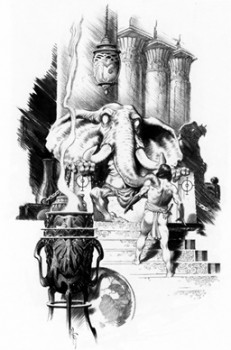 No – Commoner Who is Really a King
No – Commoner Who is Really a King
Yes– Old Wizard Guides the Hero
Yes – Enchanted Sword or other Artefact of Great Magic
Yes – A Quest for a Relic, Sometimes a Vessel, With Powers on a God-Like Scale
Yes – Diverse companions
Conan sets out to steal the fabled jewel, The Heart of the Elephant. It’s kept in the Tower of the Elephant, abode of Yara the Priest. He partners up with Taurus the thief, encounters an alien creature with magical powers and obtains the jewel, which is actually a weapon and a quest relic.
This story is really considered the point where the Conan stories hit their stride and the enduring legacy began. It has been pointed out that it was the first story written after Howard solidified his world building with his essay, “The Hyborian Age.”
So…
For purposes of this essay, we can also note that the first Conan story hit two of the five Arthurian marks. The next two stories were rejected by Weird Tales editor Farnsworth Wright and were not published until after Howard’s death. Both also scored 0 on the Arthurian scale.
“The Tower of the Elephant” scored a 4 out of 5 (the maximum possible for a Conan tale, as the first characteristic is impossible for the Cimmerian) and was quite popular. So, the first story hit on the two key Arthurian elements (wizard and sword). The next two stories had no hallmarks of the Arthurian legacy and didn’t make it into print. The fourth story touched all the (possible) bases and was a home run, truly launching the Conan Canon. How about that?
Assuming anybody actually reads this post, I’ll do a follow up, looking at the next eight or ten stories in light of the Arthurian scale, digging a little bit more into one or two that score well (“The Scarlet Citadel” hits at least two marks).
Fascinating.
OK, you’ve got one reader here. If you have the time, I’d be interested in seeing your take on Conan’s stories in light of the Arthurian scale.
I agree with your conclusions regarding the police procedural in The God in the Bowl. I believe it adds a great deal to that story.
I don’t know, I think checking four boxes for Tower of the Elephant might be stretching it a bit. Taurus appears for only one scene in which he cooperates with Conan. I would hardly call this “Diverse Companions” who accompany the hero on his adventures. Same with the alien. You could just as well say it’s a “dying messenger”. Again, it’s just a single scene in which he tells Conan the method by which the sorcerer can be defeated. That hardly makes him Merlin.
If we set the standards that low, it’s indeed very unlikely to find many stories in which these elements are not present.
Thanks. What a fascinating post. Notably, King Kull the original hero of ‘Phoenix on the Sword’ when it was ‘By this Axe I Rule’ did have a regular cast of companions. Prospero in Sword is the analogue for Brule the Spear-slayer in Axe. Solomon Kane had a spiritual guide, El Borak had supporting characters, Bran mak Morn was truly a man alone. Howard was making clear choices between the tropes available to him, to create specific moods.
Well, REH was making a different type of Heroic Fantasy. He’d have been first in line of people wanting to smack anyone de-constructing the King Arthur mythos but he was breaking the mold to make his own thing.
I’d wondered once or twice what if King Arthur somehow met Conan… Well, likely first think he’d be a barbarian to kill, drive away or subdue. Conan – deliberately – would have more in common with the wild Celts. On the other hand, if he knew him better he might have wanted to recruit him as a Knight, though the excessive sexual conquests might have made him worry it would cause him trouble. Lancelot was likely as strong as Conan and he could trust him alone with his wife…
Arthur would have really liked to meet Kull, however…
His criteria sounds better suited to Epic Fantasy than Sword & Sorcery – or has that genre description been supplanted by ‘Heroic Fantasy’? Sword & Sorcery characters are usually solitary and morally ambivalent to the point of nihilism. Format-wise, short is good – ie, stories & novellas.
I’m guessing the latter is a reflection of their pulp origins.
I believe at one point Heroic Fantasy meant all fiction about medievalesque worlds with heroic warriors. Like at some other time, all of it was called High Fantasy. The idea that Heroic Fantasy is High Fantasy that is not Epic Fantasy is somewhat more recent.
Martin – Fair points. Taurus has always seemed to me to be almost a mythic companion of Conan. He looms large in the history. So, I scored that category a 1.
Since my initial assertion was that the Conan tales don’t score high on this scale, I don’t think the standard is too low. I don’t expect many 3 scores.
I certainly feel that the book the scale is coming from is geared more towards the epic fantasy fan, rather than swords and sorcery. Though I haven’t read it all yet. It’s got quite a few essays.
I’d say Elric gets 1, so do Fafhrd and Grey Mouser. Kane gets 0, though in case of Bloodstone it’s 1.
Interestingly, this 1 is always related to magic items and Arthur hardly invented this idea.
[…] BOB BYRNE – “By Crom: Arthurian Elements in the Conan Canon’” – Black Gate– LINK […]